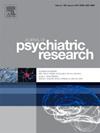Effect of methylphenidate exposure on glutamate and glutamate-related metabolites in patients with ADHD: a systematic review
IF 3.7
2区 医学
Q1 PSYCHIATRY
引用次数: 0
Abstract
Background
Dysfunctional glutamatergic neurotransmission has been implicated in the underlying pathogenesis of Attention Deficit Hyperactivity Disorder (ADHD). The psychostimulant methylphenidate (MPH), which is used as a first line treatment for ADHD, has been shown to have both acute and chronic effects on prefrontal cortex glutamatergic afferents. Animal studies have also identified an effect of MPH and glutamate in prefrontal areas. Despite this there are ongoing questions as to the extent and direction of this effect, as well as its impact on other neurobiological processes.
Methods
A systematic literature search was conducted following the PRISMA guidelines through the databases Embase, ScienceDirect and PubMed. Studies following pre/post and prospective designs were reviewed. Brain regions, metabolites of interest and phenotypical information were extracted from the relevant studies. Quality assessment tools of the National Heart, Lung, and Blood Institute were used to evaluate the risk of bias.
Results
There were 10 studies that met criteria for inclusion. Three studies in children with ADHD identified a statistically significant decrease in glutamate level within fronto-cerebellar circuit and amygdala after MPH treatment. Most studies investigating adults with ADHD did not show a significant change in glutamate and glutamate-related metabolites after MPH exposure.
Conclusion
A trend for decreased glutamate levels after MPH exposure were observed in studies involving children with ADHD. Future studies investigating the effects of MPH in children and adults with ADHD should utilise higher magnet field strength with larger sample sizes and over a longer duration of time with blinding and control group research design.
哌甲酯暴露对ADHD患者谷氨酸和谷氨酸相关代谢物的影响:一项系统综述
研究背景:功能障碍的谷氨酸神经传递与注意缺陷多动障碍(ADHD)的潜在发病机制有关。精神兴奋剂哌醋甲酯(MPH),作为治疗多动症的一线药物,已被证明对前额皮质谷氨酸能传入神经有急性和慢性影响。动物研究也发现了MPH和谷氨酸对前额叶区域的影响。尽管如此,关于这种影响的程度和方向,以及它对其他神经生物学过程的影响,仍然存在一些问题。方法按照PRISMA指南,通过Embase、ScienceDirect和PubMed数据库进行系统的文献检索。回顾了前后和前瞻性设计的研究。从相关研究中提取脑区域、感兴趣的代谢物和表型信息。使用国家心脏、肺和血液研究所的质量评估工具来评估偏倚风险。结果10项研究符合纳入标准。三项针对ADHD儿童的研究发现,在MPH治疗后,额小脑回路和杏仁核内的谷氨酸水平有统计学意义的降低。大多数调查ADHD成人的研究并没有显示出暴露于MPH后谷氨酸和谷氨酸相关代谢物的显著变化。结论在涉及ADHD儿童的研究中观察到MPH暴露后谷氨酸水平下降的趋势。未来研究MPH对儿童和成人ADHD的影响应该采用更大样本量、更高磁场强度、更长时间的盲法和对照组研究设计。
本文章由计算机程序翻译,如有差异,请以英文原文为准。
求助全文
约1分钟内获得全文
求助全文
来源期刊

Journal of psychiatric research
医学-精神病学
CiteScore
7.30
自引率
2.10%
发文量
622
审稿时长
130 days
期刊介绍:
Founded in 1961 to report on the latest work in psychiatry and cognate disciplines, the Journal of Psychiatric Research is dedicated to innovative and timely studies of four important areas of research:
(1) clinical studies of all disciplines relating to psychiatric illness, as well as normal human behaviour, including biochemical, physiological, genetic, environmental, social, psychological and epidemiological factors;
(2) basic studies pertaining to psychiatry in such fields as neuropsychopharmacology, neuroendocrinology, electrophysiology, genetics, experimental psychology and epidemiology;
(3) the growing application of clinical laboratory techniques in psychiatry, including imagery and spectroscopy of the brain, molecular biology and computer sciences;
 求助内容:
求助内容: 应助结果提醒方式:
应助结果提醒方式:


